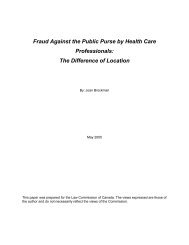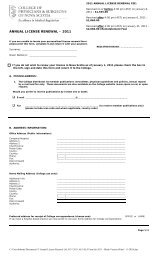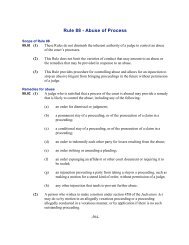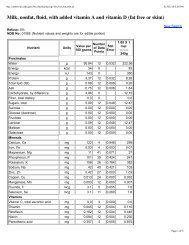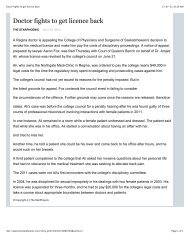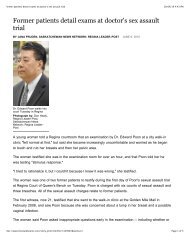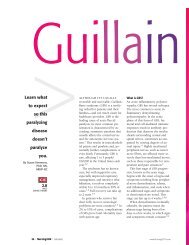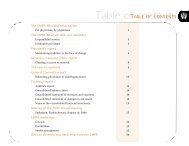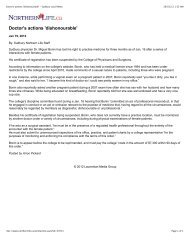Experiments That Changed Nutritional Thinking - TUUM EST
Experiments That Changed Nutritional Thinking - TUUM EST
Experiments That Changed Nutritional Thinking - TUUM EST
Create successful ePaper yourself
Turn your PDF publications into a flip-book with our unique Google optimized e-Paper software.
1044S<br />
SUPPLEMENT<br />
FIGURE 1 Intermediates in the conversion of tryptophan to niacin<br />
in N. crassa and rats.<br />
Trp / AA (Thr or Lys) r Protein<br />
f<br />
Niacin<br />
When an essential amino acid, such as threonine, is supplied<br />
at just below the optimum level, moderately good growth oc-<br />
curs and the marginal tryptophan level meets the needs for<br />
both protein and niacin synthesis. When the threonine in the<br />
The most likely explanation for the interchangeability of<br />
niacin, required at 1 mg% of the diet, and tryptophan, required<br />
at 40 times that molar concentration, was the conversion of<br />
tryptophan to niacin. The fact that 2% acid-hydrolyzed casein<br />
(tryptophan destroyed) could replace 40% corn grits in causing<br />
the deficiency suggested that an increase in the levels of other<br />
amino acids was inducing the deficiency. This effect was<br />
termed ‘‘amino acid imbalance.’’ The amino acids most effective<br />
in producing the deficiency were threonine and lysine<br />
(Hankes et al. 1948), but additional sulfur amino acids were<br />
needed to maximize the effect. Therefore, in subsequent studies<br />
0.2% L-cystine was added to the basal diet (Table 1). The<br />
explanation offered for the effect of other amino acids on the<br />
growth of rats fed the 9% casein / 0.2% L-cystine diets is<br />
illustrated as follows:<br />
diet is elevated, protein synthesis increases, tryptophan is<br />
drawn into this function at the expense of the alternate pathway<br />
to niacin, and the vitamin deficiency results. <strong>That</strong> this<br />
explanation for the effect of threonine is valid is supported by<br />
the results of similar imbalance studies that showed that lysine,<br />
valine, leucine and isoleucine also produce growth inhibition<br />
that is reversed by tryptophan or niacin (Koeppe and Henderson<br />
1955).<br />
Many isotopic labeling studies with rats have confirmed<br />
the conversion of tryptophan to niacin. The first evidence<br />
regarding the reactions involved came from experiments with<br />
mutants of the mold Neurospora crassa (Fig. 1). The first four<br />
compounds in this scheme were verified in animal systems,<br />
and quinolinic acid was added when it was identified as an<br />
excretory product of tryptophan in mammals and a rather<br />
ineffective niacin substitute in rats and a niacin-less mutant<br />
of N. crassa (Henderson 1949).<br />
Quinolinic and picolinic acids are formed by the incubation<br />
of 3-hydroxyanthranilate with mammalian liver (Fig. 2). Nei-<br />
ther is degraded to carbon dioxide even in vivo. <strong>That</strong> they<br />
arise from intermediates in the degradation of tryptophan to<br />
glutarate was established by the report of Gholson et al.<br />
(1962). It is evident that picolinate and quinolinate arise by<br />
formation of cyclic Shiff’s bases from intermediates in the<br />
degradation of tryptophan, and they can be considered side<br />
reaction products of the degradative pathway.<br />
The limited activity of exogenous quinolinate as a dietary<br />
replacement for niacin cast doubt on its intermediary role in<br />
the formation of niacin. This limited activity probably results<br />
from the failure of the salts of quinolinic acid to penetrate the<br />
cells in which it normally arises. It is a strong acid and because<br />
it is obliged to enter cells in the undissociated form, a proper<br />
pH for its penetration is much below physiological pH values.<br />
The role of quinolinate in the formation of niacin was clarified<br />
Downloaded from jn.nutrition.org by on June 3, 2010<br />
FIGURE 2<br />
Simplified scheme for the total metabolism of tryptophan and its conversion to pyridinium compounds, including niacin.<br />
/ 4p09$$0062 04-07-97 14:02:12 nutras LP: J Nut May Suppl





